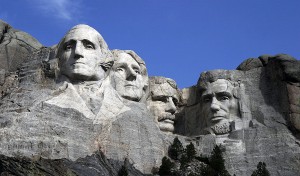 There are not many places where you can find American history, carved in stone, and as big as a mountain! One of America’s most unique and valued treasures, Mount Rushmore National Memorial is visited by nearly three million people each year that come to marvel at the majestic beauty of the Black Hills of South Dakota and learn about the birth, growth and development of this great country. From the history of the first inhabitants to the diversity of America today, Mount Rushmore brings visitors face-to-face (literally) with the history we all share.
There are not many places where you can find American history, carved in stone, and as big as a mountain! One of America’s most unique and valued treasures, Mount Rushmore National Memorial is visited by nearly three million people each year that come to marvel at the majestic beauty of the Black Hills of South Dakota and learn about the birth, growth and development of this great country. From the history of the first inhabitants to the diversity of America today, Mount Rushmore brings visitors face-to-face (literally) with the history we all share.
Mount Rushmore was born in 1884 when prominent New York lawyer Charles E. Rushmore traveled to the Black Hills to inspect mining claims in the region. When Rushmore asked a local about the name of a nearby mountain, the man replied that the mountain never had a name, but from now on it would be known as Rushmore Peak. It was later changed to Rushmore Mountain and then Mount Rushmore, as we know it today.
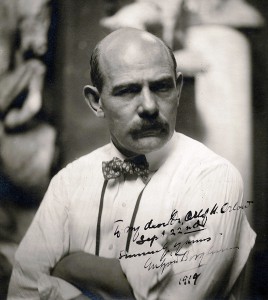 In the 1920’s, looking to attract tourism to the Black Hills, South Dakota historian Doane Robinson came up with the idea to sculpt the “Needles” (several giant natural granite pillars) into the likenesses of famous people. Robinson wanted to feature western heroes like Red Cloud (a Sioux chief) and Buffalo Bill Cody. American sculptor Gutzon Borglum (see photo) was contacted in 1924 and asked to do the carving. Mr. Borglum accepted the project, but instead of western heroes, he suggested George Washington, Abraham Lincoln, Thomas Jefferson and Theodore Roosevelt, because he felt they would attract more of a national interest.
In the 1920’s, looking to attract tourism to the Black Hills, South Dakota historian Doane Robinson came up with the idea to sculpt the “Needles” (several giant natural granite pillars) into the likenesses of famous people. Robinson wanted to feature western heroes like Red Cloud (a Sioux chief) and Buffalo Bill Cody. American sculptor Gutzon Borglum (see photo) was contacted in 1924 and asked to do the carving. Mr. Borglum accepted the project, but instead of western heroes, he suggested George Washington, Abraham Lincoln, Thomas Jefferson and Theodore Roosevelt, because he felt they would attract more of a national interest.
During his second visit to the Black Hills in August 1925, Borglum rejected the “Needles” site because of the poor quality of the granite and strong opposition from Native American groups. Eventually, they chose the Mount Rushmore location, which also had the advantage of facing southeast for maximum sun exposure. Aided by Black Hills city mayor and Senator Peter Norbeck, among others, Robinson worked tirelessly to acquire funding for the project. President Calvin Coolidge gave the official dedication speech at Mount Rushmore on August 10, 1927, and then the carving began.
Along with the traditional drills and chisels, Borglum utilized new methods to carve the four presidential heads that involved dynamite and pneumatic hammers to blast through large amounts of rock quickly. The 450,000 tons of rock that he and 400 workers removed to carve the 60-foot tall faces still remains in a pile at the base of the mountain. The face of Thomas Jefferson was originally intended to appear in the area at Washington’s right, but after the work there was begun, the rock was found to be unsuitable, so the work on the Jefferson figure was “removed” using dynamite and then a new figure was sculpted to Washington’s left. It was dangerous and arduous work, but, amazingly, no lives were lost during the entire project (see photo).
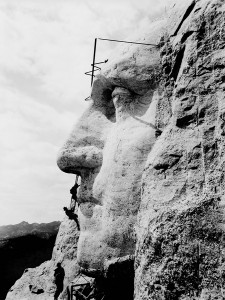 Originally, it was planned that all of the figures would be carved from head to waist, but insufficient funding forced the carving to end. Sadly, the finishing details of Mount Rushmore were left to Gutzon Borglum’s son, Lincoln, as Gutzon died in March 1941 just months before the final dedication ceremony was held on October 31, 1941.
Originally, it was planned that all of the figures would be carved from head to waist, but insufficient funding forced the carving to end. Sadly, the finishing details of Mount Rushmore were left to Gutzon Borglum’s son, Lincoln, as Gutzon died in March 1941 just months before the final dedication ceremony was held on October 31, 1941.
Although it cost less than $1 million to complete the entire project, in 1991, on its 50th anniversary, the monument underwent a full restoration – at the price of $40 million. The Mount Rushmore National Memorial encompasses about 1,300 acres. The flags of 56 states and territories fly below the memorial down the Avenue of Flags. The Avenue leads from the concession building to the Grandview Terrace and Presidential Trail, a short hiking path offering spectacular views. May through September a lighting ceremony is held in the park’s amphitheater at about 9:00 p.m. each night. Interpretive programs, exhibits and a film are offered at the Lincoln Borglum Museum.
Besides Mount Rushmore, there is so much to see and do in the legendary Black Hills of South Dakota, where you will find six national parks (Badlands National Park alone is 244,000 acres of rugged beauty to explore), 101 miles of National Scenic Byways, hiking trails, and Old West landmarks like Wounded
Knee and Deadwood. The region enjoys an unmatched brand of Old West history, and tied to it are names like Crazy Horse, Sitting Bull, General George A. Custer, Wild Bill Hickok and Calamity Jane, to name a few.
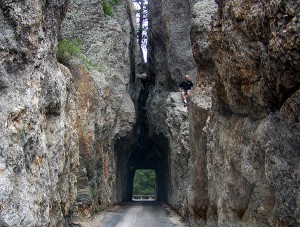 Years ago, I went to the 1880’s town that was used for the filming of the movie Dances with Wolves, and it was worth the stop. Walking down dirt streets in a town set up like it really used to be, out in the middle of nowhere, makes you really appreciate how good we have it today.
Years ago, I went to the 1880’s town that was used for the filming of the movie Dances with Wolves, and it was worth the stop. Walking down dirt streets in a town set up like it really used to be, out in the middle of nowhere, makes you really appreciate how good we have it today.
Keystone is a tiny town near the base of Mount Rushmore that has lots to see and do. The Black Hills Central Railroad operates an 1880 steam train that takes you on a 2-hour round trip – it’s not fast, but it is cool. Big Thunder Gold Mine is a free museum and has the largest collection of mining equipment in the Black Hills. You can also pan for gold and learn about the men who did it back then.
In the 1870s, Deadwood Gulch was the site of the last big frontier gold rush in the United States. Fueled by greed, Deadwood began as a lawless camp of prospectors and a business district comprised of saloons, dance halls, card parlors and bodacious bordellos. Today, the entire town of Deadwood is a National Historic Landmark.
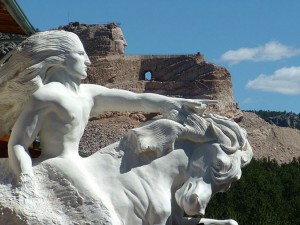 You won’t want to be in a rush when you drive the Needles Highway. As part of the Peter Norbeck Scenic Byway, the Needles Highway stretches 14 miles through granite structures and pine-covered mountains. With so much scenery to absorb, don’t be surprised if you find yourself driving 20 miles per hour. You cannot, I repeat NOT take a truck on this route (SD-87), which leads to Custer State Park, but if you aren’t in a truck, I highly recommend taking this amazing drive, which includes a passage through the very narrow Needle’s Eye Tunnel (see photo).
You won’t want to be in a rush when you drive the Needles Highway. As part of the Peter Norbeck Scenic Byway, the Needles Highway stretches 14 miles through granite structures and pine-covered mountains. With so much scenery to absorb, don’t be surprised if you find yourself driving 20 miles per hour. You cannot, I repeat NOT take a truck on this route (SD-87), which leads to Custer State Park, but if you aren’t in a truck, I highly recommend taking this amazing drive, which includes a passage through the very narrow Needle’s Eye Tunnel (see photo).
It’s a little known fact that Jewel Cave, located in the Black Hills, is the 3rd longest cave in the world. With over 168 miles of known passages, this underground wilderness appeals to human curiosity. Its splendor is revealed through fragile formations and glimpses of brilliant color. This resource is truly a “jewel” in the National Park Service.
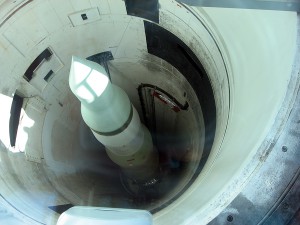 When it’s completed, the Crazy Horse Memorial will be the largest of its kind in the world. The memorial is being carved out of Thunderhead Mountain 17 miles from Mount Rushmore. The sculpture’s final dimensions are planned to be 641 feet wide and 563 feet high. The head of Crazy Horse will be 87 feet tall! While blasting has continued for 60 years since the project began, it will be years before it’s ever completed. Unlike Mount Rushmore, which is just faces on one side of a mountain, this memorial will encompass almost the entire mountain and be visible from both sides (see photo).
When it’s completed, the Crazy Horse Memorial will be the largest of its kind in the world. The memorial is being carved out of Thunderhead Mountain 17 miles from Mount Rushmore. The sculpture’s final dimensions are planned to be 641 feet wide and 563 feet high. The head of Crazy Horse will be 87 feet tall! While blasting has continued for 60 years since the project began, it will be years before it’s ever completed. Unlike Mount Rushmore, which is just faces on one side of a mountain, this memorial will encompass almost the entire mountain and be visible from both sides (see photo).
Another interesting site you can visit near the Badlands is the Minuteman Missile National Historic Site. In 1962, President Kennedy dubbed this his “Ace in the Hole” for obvious reasons. Today, you can see the underground silo and launch control center where a Minuteman intercontinental ballistic missile carrying a 1.2 megaton warhead (equivalent to one million tons of dynamite) once called home. Now, there is an unarmed missile in the 80-foot deep silo, but it is a stark reminder of the Cold War days (see photo).
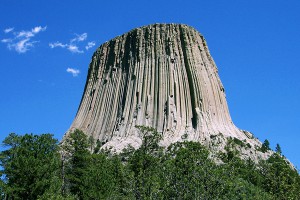 Not far from the other attractions in the Badlands is Devils Tower in northeastern Wyoming, which rises dramatically 1,267 feet above the surrounding terrain. Devils Tower was the first declared National Monument in the United States, established on September 24, 1906, by President Theodore Roosevelt. Not only can you look at this beautiful tower of rock, but you can climb it, too. About 1% of the monument’s 400,000 annual visitors climb the tower, mostly using traditional climbing techniques (see photo).
Not far from the other attractions in the Badlands is Devils Tower in northeastern Wyoming, which rises dramatically 1,267 feet above the surrounding terrain. Devils Tower was the first declared National Monument in the United States, established on September 24, 1906, by President Theodore Roosevelt. Not only can you look at this beautiful tower of rock, but you can climb it, too. About 1% of the monument’s 400,000 annual visitors climb the tower, mostly using traditional climbing techniques (see photo).
You would need a week or more to even begin to see everything in this amazing area of our country. If you’re a trucker and want to see everything, you should consider renting a car. All of these “attractions” are accessible by car, but if you are in a truck, you might want to call ahead and check to see where you can and can’t go. I implore you to get on your computer and search for these places – you will be amazed and mesmerized by the beauty of both Mount Rushmore and the entire Black Hills region.
